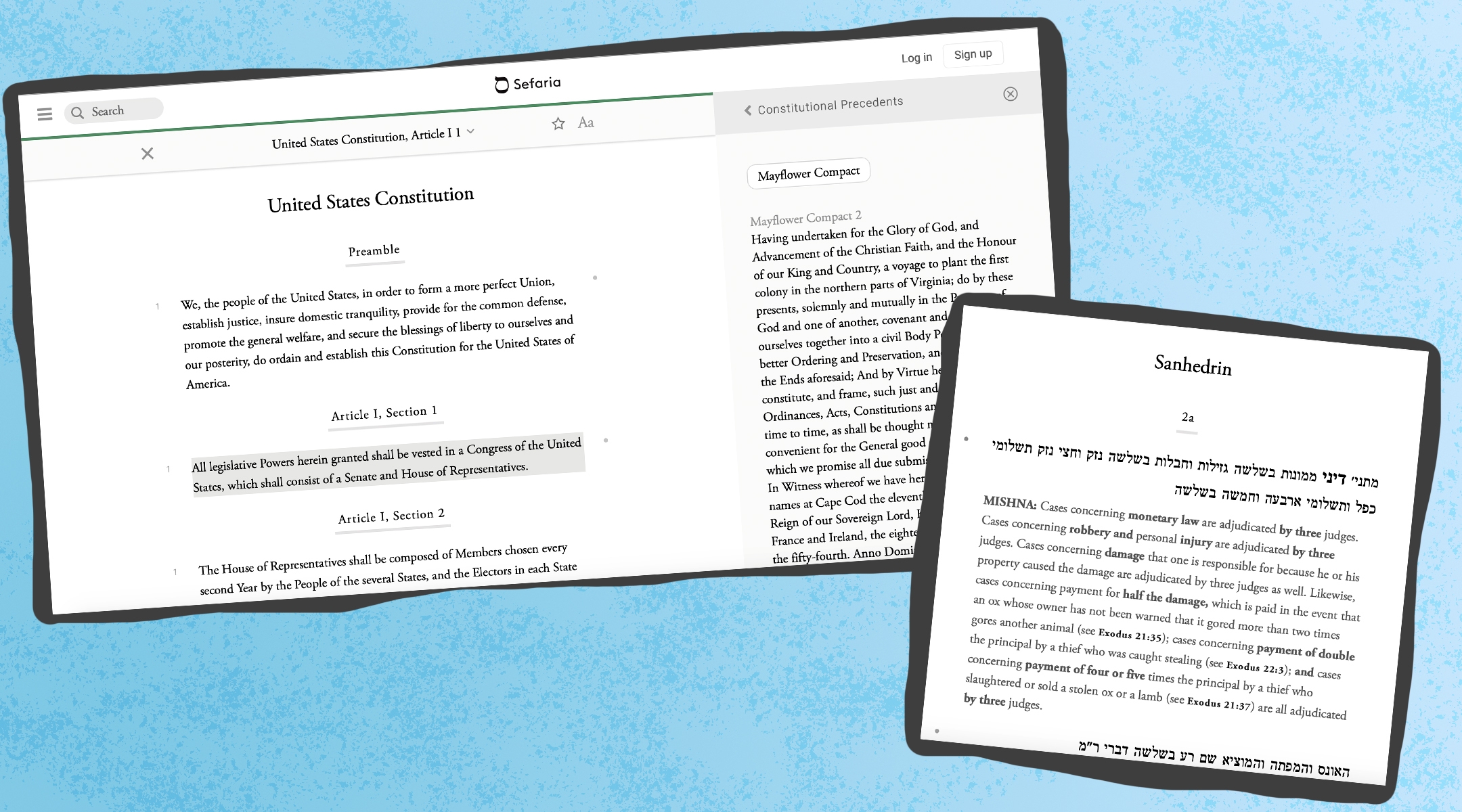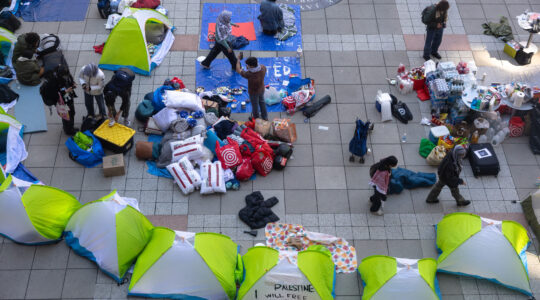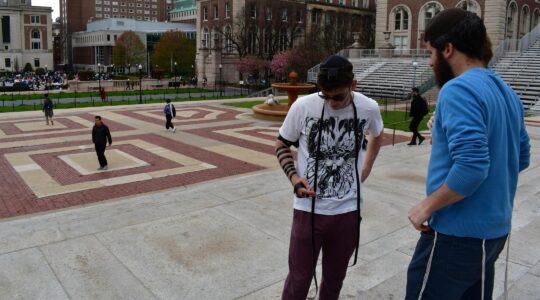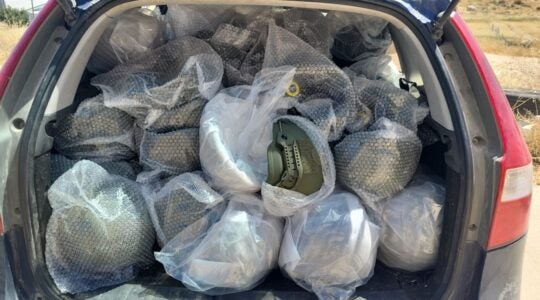(JTA) – Could democracy take a page from the Talmud?
The creators of Sefaria, a project to digitize Jewish texts, think so.
Since 2012 Sefaria, a database of Jewish writings that allows users to read two texts side by side with an eye to the connections between them, has offered free access to classic Jewish texts to millions of users each year, establishing itself as an invaluable resource for teachers, students and writers.
Now it’s applying the same approach to foundational texts from a different system of thought: that of American democracy. It launched the project, fittingly, on July 4 with a small library of texts including the U.S. Constitution, the Federalist Papers and a selection of presidential addresses — all laid out connected by hyperlinks and the ability to read them side by side.
The project is just a prototype for now, but one Sefaria is hoping to replicate as the organization thinks through how to apply its approach to connecting and presenting texts to other bodies of knowledge beyond the Jewish canon.
We talked with Brett Lockspeiser, Sefaria’s chief technology officer and a co-founder, about the power of new technology to reinvigorate old texts, what makes the Constitution like the Talmud (and why it stands apart) and what Jewish texts have to say about civil discourse. (Sefaria’s CEO, Daniel Septimus, is a board member of 70 Faces Media, JTA’s parent company.)
JTA: Can you explain what makes Sefaria different from other databases of texts and why it works for something like the Constitution and related texts?
Lockspeiser: The real magic of Sefaria – and this is the real magic of the Torah tradition, it’s not something we invented – is in the interconnections. Just putting texts on websites is not particularly novel and not particularly interesting in itself. It gets exciting when you click on a line of text and then a sidebar opens and you get this whole array of voices that are talking to that point and you open things up side by side.
Doing that for the Jewish case has actually been a lot easier than we found it to be in this case because our tradition has so firmly baked in this idea of citing sources and relating everything you do to texts that came before and this idea of having commentaries that are really line-by-line commentaries. So many texts in Sefaria are structured, so you know this particular Rashi or Ramban is talking about this line of Talmud.
So what that meant for us is that our process of building our library of connections — and in Sefaria, I think we have about 3 million connections between texts identified — most of those we were able to just grab them from the tradition. They had already been created, we just had to digitize them.
Something we found in the democracy texts is you’re not necessarily sitting on thousands of years of very clearly specified citations of interconnections. So a lot of what we’re doing is trying to mine different techniques for how we relate texts to one another.
Have you found connections between the Jewish texts and democracy texts that you hadn’t noticed before?
What I’m feeling is the structural connection, this feeling of a textual tradition being something where textual voices are talking to each other across time and space. It feels like that’s happening here and that feels like such a Jewish thing, having different voices of text be the anchoring voice that we relate to each other with. I feel like it’s not an exclusively Jewish phenomenon in the world, but it’s cool to see the parallels.
Do you think there’s anything that people who are focused more on non-Jewish texts could learn from the way Jewish texts interact with each other?
It is really one of the core principles to interact. We want multiple voices, you don’t want to boil things down to a bottom line all the time. You want to appreciate the tension that happens between multiple voices. We do that often by printing them side by side. That’s a principle of the democratic process, of democratic society, is wanting to be able to respect different voices playing a role. The text can serve as a model of what we want our society to look like.
How much are you thinking about who is represented in these democracy texts, which are largely written by white men (Barack Obama being the exception)? And how do you think about whose voices are represented when it comes to the Jewish library?
It’s kind of haphazard what we’ve added in there. We sort of tried to start from the Constitution and just pull out from there everything that we could throw into it. A lot of our process has been more about building a database, saying we have this software which is the vessel and we’re trying to throw things in it. Going forward with the project, if it’s going to be a real serious project, that’s going to be an important consideration. And that’s become an active area of work for Sefaria in our Jewish library.
So we’ve been more proactive in going out and trying to add Torah voices by women and people of color to the library. The first big step with that was last year when we signed a big deal to be able to publish the source sheets of Nechama Leibowitz.
Because most of those voices are more recent, most of those voices are under copyright. So it’s a harder process for us. When we’re not dealing with public domain texts, we have to negotiate with the content owners. We’re also actively working on texts specifically for the Mizrahi community that we feel like in our first pass, we didn’t pay enough attention to. We’ve gotten a lot of feedback from our users, so we’re working through a list of works that we’re going after.
What are the other applications that you’re thinking of for the Sefaria software and its unique approach to text?
We’ve been thinking about all different options. We think about other areas in literature, American poetry. We think about Shakespeare. We think about Christian texts. We get a lot of requests from people who want to have a Sefaria for Christian texts or Muslim texts, other religious traditions. We’ve gotten requests from people in science and medical fields to be able to read medical journals in this side-by-side experience.
What about Jewish texts that aren’t, strictly speaking, Torah texts? Like Jewish literature?
In some ways it’s harder for us to figure out what extends from the Torah tradition. Our texts are really Torah texts. There’s a religious Jewish tradition of texts and there’s a whole world, like Yiddish literature, Zionist literature, which is not necessarily in the Torah tradition but it’s really close to it. So we’ve definitely thought about it, and then the question becomes should it be a separate library, a separate site, that’s all about Zionist literature or Yiddish literature? Or should it be a corner of Sefaria? So basically it’s something we’re considering now.
What do you see as the long-term future of Sefaria?
The process of dealing with data and creating software doesn’t end because software is always changing and the technologies we have are always changing. There is an unending need to have an organization to continually develop the technology that holds Torah, even if it’s just the Torah that exists already, just to keep that relevant and useful. The new iPhone comes out, and the new VR experience comes out, and the new brain implant chip for learning text comes out. Just to keep the digital experience relevant is an unending process.
I think that adding texts to the library and adding features to the library is also somewhat of an unending process, and changing the kinds of experiences that people are capable of having with our texts, I see that as an ongoing process that we have to keep up with. And then there is this vision that maybe it’s not just our organization but maybe it becomes this federation of organizations that are responsible for different libraries of content. That we are the organization that specializes in the Jewish text, and maybe there’s another organization that comes up that is responsible for the constitutional texts or for the Muslim texts and being able to federate the technology that we’ve built so we can spread this idea that these texts want to be available to people and they want to be in conversation now. That’s a beautiful vision and that’s what we’re dipping our toes into right now.






